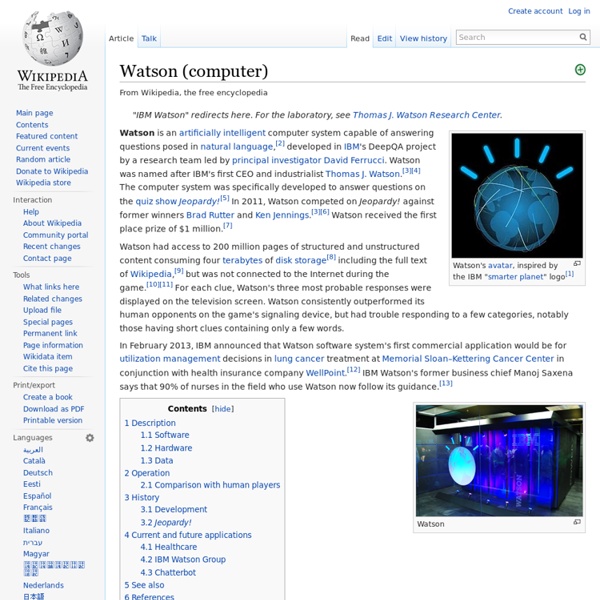Watson (computer)
Watson is an artificially intelligent computer system capable of answering questions posed in natural language,[2] developed in IBM's DeepQA project by a research team led by principal investigator David Ferrucci. Watson was named after IBM's first CEO and industrialist Thomas J. Watson.[3][4] The computer system was specifically developed to answer questions on the quiz show Jeopardy![5] In 2011, Watson competed on Jeopardy! against former winners Brad Rutter and Ken Jennings.[3][6] Watson received the first place prize of $1 million.[7] Watson had access to 200 million pages of structured and unstructured content consuming four terabytes of disk storage[8] including the full text of Wikipedia,[9] but was not connected to the Internet during the game.[10][11] For each clue, Watson's three most probable responses were displayed on the television screen. The high-level architecture of IBM's DeepQA used in Watson[14] When playing Jeopardy! The Jeopardy!
Computers, A.I.
! Introduction to NeuroAesthetics !
Articles and papers on neuroesthetics
The Neural Sources of Salvador Dali's Ambiguity S Zeki Coming soon ! The neural correlates of beauty S Zeki and H Kawabata Journal of Neurophysiology (J Neurophysiol 91: 1699-1705, 2004) PDF Cerveau & Psycho Special edition of Pour la Science nº 2 juin-août 2003 This contains several articles of interest to neuroesthetics Cervello pittore L Ticini Stile e Arte Maggio (2003) Page 1 2 Hearing colors, tasting shapes V S Ramachandran and E M Hubbard Scientific American May (2003) Website La creatività artistica e il cervello L Ticini Arte & Cultura Marzo (2003) PDF Trying to make sense of art S Zeki Nature 418:918-919 29 August (2002) PDF Neural concept formation and art: Dante, Michelangelo, Wagner S Zeki Journal of Consciousness Studies 9, 53-76 (2002) PDF Artistic creativity and the brain S Zeki Science 293, 51-52 (2001) PDF The science of art.
Computational advancement and future
Starts at 33:50 min
Starts at 33:45
NeuroAesthetics - Science on Art
Wolfram Alpha
Rise of Neurocinema: How Hollywood Studios Harness Your Brainwaves to Win Oscars
One thing you aren't likely to hear Sunday night from the Oscar-winning producer after accepting the trophy for Best Picture: "I'd like to thank my neuroscience partners who helped us enhance the film's script, characters, and scenes." It's not that far-fetched, though. A sizable number of neuromarketing companies already brain test movie trailers for the major studios through fMRI, EEG, galvanic skin response, eye-tracking and other biometric approaches. For now, the test data helps the studios and distributors better market the movie. But what about using brain feedback to help make the movie? A trailblazing few firms and studios have delved into the upstart practice of "neurocinema," the method of using neurofeedback to help moviemakers vet and refine film elements such as scripts, characters, plots, scenes, and effects. Stephen Susco, who wrote the $187 million grossing horror movie Grudge, is not a practitioner of neurocinema. Other filmmakers seem divided.
Related:
Related:



